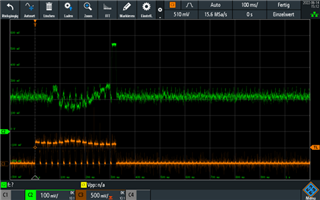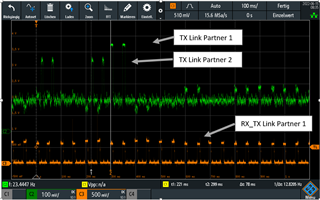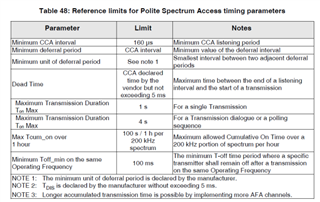Hello,
we got the following information in an earlier thread (e2e.ti.com/.../3641736). The scope was
- ETSI EN 300 220-1, specifically the "Minimum Toff_min on the same Operating Frequency" which is defined to be 100 ms,
- TI 15.4 stack from CC1352P SDK v3.20, running at Frequency Hopping ETSI LBT mode.
"When LBT is enabled, stack automatically delays transmission by 100 ms if it occurs on the same channel. Note, no delay is needed when the next transmission occurs on a different channel."
While figuring out other problems in our application, we managed to measure the transmissions of our 2 devices with good resolution in the time domain, so that we now could actually see single packet transmissions on a scope.
Devices involved:
- Link partner #1, is a 15.4 coordinator, transmits a packet each 50 ms.
- Link partner #2, is a 15.4 device, replies to each packet of the coordinator with a packet.
What is visible on the following scope screen shots:
- Channel 2, green line: Signal strength at the frequency of one channel (out of 14 configured 15.4 ETSI channels). Signal of coordinator is not attenuated, signal of device is attenuated, so they can be distinguished here.
- Channel 3, orange line: RX_TX signal of link partner #1 (coordinator). High = TX, Low = RX.
A scope screen shot from the ASYNC phase (that maybe gets you familiar with our measurements): Orange line shows 14 transmissions in one row. Green line shows good signal strength for last channel.

Following scope screen shots were recorded during "link up" phase in our application with regular packet transmissions.

The one above shows two consecutive transmissions on the observed channel, from same device; transmissions distance is 50 ms.
The one above shows the case that the same channel is chosen again (DH1CF sequence...clarified also in previous post) after a 100 ms dwell time interval, which results in 4 transmissions on our observed channel within 200 ms.
Also, as above, the case that 2 transmissions take place on our observed channel within 100 ms, is included two more times.
Now, this does not exactly meet our expectation. From the related thread, we had understood that the stack takes care of keeping 100 ms TX Off time demanded by regulations in ETSI LBT mode. Can you clarify this please? We could also imagine that there is some misunderstanding of the TX Off time on our side, so we hope you can shed some light on this for us.
Thanks and best regards,
hkr



